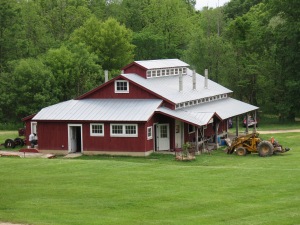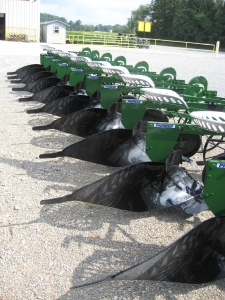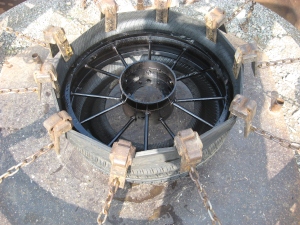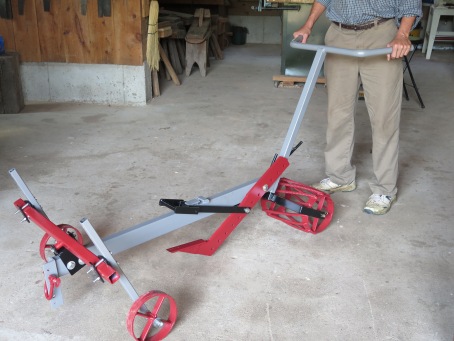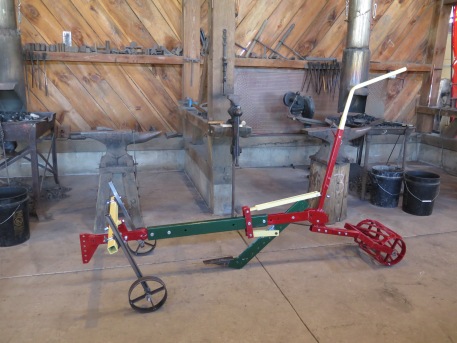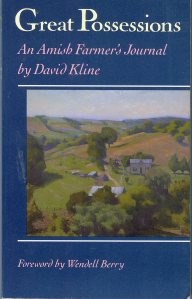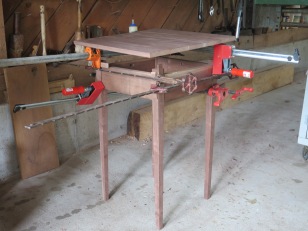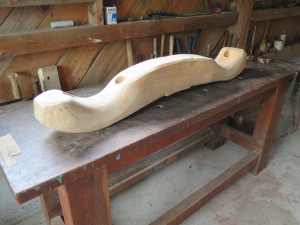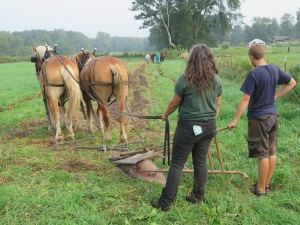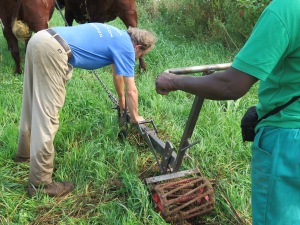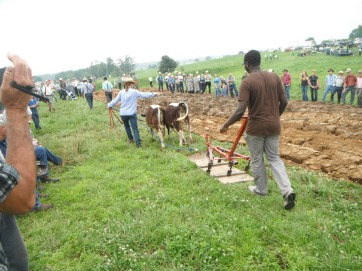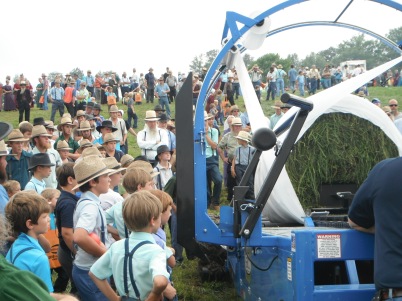In agriculture, our free trade and commodity export agendas conflict with our development agenda, and the result is food insecurity. Here is the case for a change in focus.
BY MICHAEL MCCLELLAN

Millions of cattle could be put to work as draft animals on small farms in South Sudan. Doing so requires low cash inputs and low-level technology. And, typically, according to
Tillers International, it will double or triple a small farm’s output over hand labor.
Michael McClellan
World food security is rightly a high priority for the United States. While the large U.S. commodity sector and industrial agriculture clearly reap the benefits of our commodity food aid, support of global trade and export promotion, such short-term “aid” does not help other countries to develop their own food security. In fact, as it stands, our free trade and commodity export agendas are in conflict with our development agenda—and this conflict ultimately leads to food dependency, not food security.
Instead of a focus on promoting commodity exports and the adoption of biotech and industrial farming products and techniques pitched by American agribusiness, our focus should be on people, land and communities. Because it relies more on development of local food sources than on a global trading system that primarily benefits large corporations, such an approach will build food security abroad.
Our objective should not be to “feed the world,” but rather to “enable the world to feed itself.” In doing so, we will set an example for other rich nations to follow in supporting sustainable farming globally.
Advancing Food Security
To truly advance our food security agenda, and improve America’s image abroad in the bargain, we need to adopt a five-part agenda that:
- promotes sustainable and environmentally responsible stewardship of the land;
- minimizes cash inputs such as fertilizers, pesticides, herbicides and imported equipment;
- keeps people on the land through support for small-scale farms and does not displace them into urban areas;
- fosters reliance on traditional, nonpatented seeds and local “heritage” livestock breeds; and
- promotes a better environment through improvement of soils, improved water usage and better carbon sequestration.
Our objective should not be to “feed the world,” but rather to “enable the world to feed itself.”
In short, American foreign policy should promote organic, small-scale, diversified, sustainable farming practices and not large-scale, commodity-focused agriculture that relies on chemical inputs, expensive machinery, and genetically modified seeds and other biotech practices that place production and efficiency above all else.
President Barack Obama’s “Feed the Future” initiative is a good step in the right direction, but it contrasts with other U.S. government programs that prioritize promotion of trade and exports. The U.S. Agency for International Development and the Peace Corps have several programs that promote small-scale farming, particularly women in farming, as well as organic and sustainable practices. But these programs are weak in comparison with other efforts—such as trade agreements like the Trans-Pacific Partnership—that promote the use of genetically modified organisms (GMO) and other patented seeds, chemical fertilizers, herbicides, pesticides and other costly inputs as part of global trade promotion.
Consider how American agriculture has evolved since World War II, and how it affected Americans throughout our nation’s rural areas and small towns. Growing up in rural Kentucky, I saw firsthand how farmers and small towns were hit hard by the “industrial” model of agriculture. This so-called modern agriculture was shaped mainly by corporate profitability and the incessant drive for productivity and efficiency.
What we have today across the United States are farms and farmers saddled with debt and dependent on patented seeds, both GMO and hybrid, that must be bought every year; a heavy reliance on expensive machinery that encourages large-scale farming; and dependence on chemical inputs such as herbicides, insecticides and fertilizers with potentially deleterious long-term effects. It is a farming model that relies on cash inputs from the farmer and that makes him or her dependent on large corporations and money lenders that are no longer community-based.
The New Holland Tractor: A Cautionary Tale
In 2013, while driving through South Sudan, we came upon a small shop that had a beautiful, 70-horsepower New Holland tractor sitting beside it. The tractor was obviously new, the tires had no scratches or other marks on them, but it was covered in cobwebs. It had probably never been used. The man at the shop said it had been sitting there for about a year after a government official dropped it off.
This tractor, like many other tractors dotting the South Sudanese countryside, was a gift of some country’s foreign aid program (thankfully, it was not a U.S. donation). Priced at roughly $35,000 new, the final cost was probably closer to $70,000 after accounting for shipping and delivery.
At best, that tractor may help one farmer—until it breaks down because of poor operator skills, lack of spare parts or fuel, and lack of maintenance.
Had that same $70,000 been invested in draft power—much more appropriate technology for South Sudan’s farmers—at least 30 farmers could have been set up with the full complement of tools to cultivate their land with oxen, thereby doubling or even tripling their agricultural output.
Furthermore, most or all of those implements could be manufactured in South Sudan. That would, in turn, support small businesses and shops across the country, developing a light industry that would provide urban jobs and service technicians with work for years to come. This process would strengthen rural communities and lift many rural residents out of poverty.
—M.M.
The “Get Big or Get Out” Model
This business model stems from the “get big or get out” philosophy first promulgated by Secretary of Agriculture Ezra Taft Benson in the 1950s and reinforced two decades later by Secretary Earl Butz, who told American farmers to “adapt or die.” The policy pitted farmers against their neighbors and destroyed many of the bonds that had held rural communities together; one neighbor’s failure was a growth opportunity for another. There is even research underway now in the agroindustrial complex to enable “farming without farmers,” using remotely controlled farm machinery directed by GPS and satellite mapping so that machine operation can take place around the clock without any human controls in the field. In other words, drone warfare meets farming.
The result of these practices is visible in a vast region of America’s heartland that is today largely depopulated, littered with decaying ghost towns bereft of people and small businesses. There is a devastating loss of topsoil across what was once one of the world’s richest agricultural areas. Depleted aquifers can no longer supply irrigation and drinking water. Water pollution from fertilizers and other chemical runoff has poisoned countless creeks, rivers, ponds, lakes and possibly created a massive “dead zone” in the Gulf of Mexico. And there is flooding across the country in areas that did not flood before because the soil can no longer absorb the rain that farmers rely on to grow crops.
Sadly, the increase in farmer suicides in many countries, including our own, has been directly related to this inability to “adapt,” as farmers become debt-ridden and even poisoned by the deluge of chemicals they are encouraged to use but not taught to handle responsibly. In addition, rural communities are often powerless to fight coal mining, timber interests and natural gas companies that treat once-vibrant rural farm areas as colonies to be depleted of natural resources at any cost and without regard for the environment or the people there.
Is this what we want in the rest of the world? Is it in America’s interest for Africa, Asia, Eastern Europe, Latin America and other farming regions of the world to deplete their soil and water, drive their people off the land into the cities and turn their prime farmland into large-scale commodity croplands that rapidly lose fertility, while serving mainly to generate export revenue rather than feed the local population?
No, it is not. The post-World War II model of American agriculture is only destined to make other countries increasingly dependent on foreign aid, leaving them with a weakened farming and rural infrastructure that cannot support the population. Nor is it in the interest of U.S. foreign policy to foster urban migration, driving people off the land into teeming cities with no jobs, but plenty of drugs, crime and HIV/AIDS. More “efficient” farming, in fact, often creates increased unemployment, which only leads to other problems that our assistance must then try to manage.
Our foreign policy agricultural agenda should not tell farmers around the world to “adapt or die.” Rather, we should be helping them to survive and thrive.
It is not in the interest of U.S. foreign policy to foster urban migration, driving people off the land into teeming cities with no jobs, but plenty of drugs, crime and HIV/AIDS.
Good Farming…and Its Opposite
Good farming improves the land and keeps people on the land. The Chinese have farmed their land for more than 4,000 years, as have many other cultures around the world, and their soils were fertile until the advent of “modern” farming practices in recent years. Even periodic famines in China, Ethiopia and other countries throughout history were due more to politics and lack of infrastructure than to actual food deficits. Many modern practices “mine” the soil of nutrients and minerals rather than rebuilding and growing topsoil.
Good farms are diversified, usually with a mix of crops and livestock, with nutrients added to the soil naturally. Good farms are managed by men and women who love their land and want to pass it on in good shape to their children. Good farming is a challenging, intellectual skill that requires knowledge of botany, biology, chemistry, climate, animal husbandry and even business and accounting.
Good farming, as it has been done for thousands of years around the world and is done today in the United States on small, diversified, organic farms, makes the land better and better with each passing year. There are Amish farms in Pennsylvania that have been farmed for more than 200 years by the same families, and the land is incredibly rich and verdant as a result of their sustainable, often organic, and responsible practices.
Contrast this with farms across the South and Midwest that are mono-cropped year after year with soybeans, corn and cotton, using GMO and hybrid seeds, herbicides, pesticides and chemical fertilizers that kill much of the life in the soil and pollute the groundwater and nearby bodies of water. The topsoil is steadily depleted, year after year after year. Most of this corn and soybean crop is grown to support large-scale meat production that abuses animals and pollutes the surrounding air, water and soil with toxic manure runoff that could be avoided if the animals were dispersed through free ranging and grass feeding. Such natural ways of producing meat animals are still the norm in most of the world.
The last thing the United States should be doing is encouraging other countries to make the same mistakes we did by exporting practices that serve only to enrich a few large corporations at the expense of countless small farmers and devastate the agricultural heartland of a country. Any member of the Foreign Service who has lived in Africa and eaten locally produced meat and eggs can probably tell you that they taste much better than typical U.S. supermarket fare, thanks to traditional grazing practices and natural animal foods.
The Economics of Appropriate Technology

In the Magwi region of South Sudan, Michael McClellan, then DCM in Juba, plows with oxen, the cattle typical of the area.
Courtesy of USAID
If our foreign policy objective is truly to make sure the world is fed, we should promote an agenda that will keep farmers on the land and keep the land in the hands of responsible stewards who will improve it with each passing year. We should promote organic farming approaches that rely on low-cost or no-cost inputs and that are sustainable and natural. We should not encourage farmers to take on debt or to buy expensive inputs—or pay for those inputs ourselves with grants and loan incentives through foreign aid funds. Instead, we should work with farmers to use appropriate-scale technologies, natural fertilizers and crop rotations, and a diversity of crops and livestock to ensure better protection against natural disasters, bad weather and pestilence.
At the same time, the United States should promote the licensing and production of small-scale farm technology from U.S. companies so that small American companies and the jobs they provide also benefit from international food assistance. Significant advances have been made in recent years in draft-powered farming (i.e., using horses and oxen instead of tractors), and these advances could and should be licensed for manufacture by small companies and entrepreneurs abroad, thereby encouraging manufacturing and job creation in developing countries.
By focusing on the farmers themselves, and what we can do to sustain and improve their work, U.S. agricultural policy can spend far less money and do more to promote food security abroad than we can through our current approach. We should promote knowledge and training in using appropriate-scale technologies, the use of non-patented seeds that will adapt to local growing conditions, good animal husbandry so every region of the world will develop the most appropriate livestock for its climate and terrain, and the use of natural fertilizers and supplements that do not degrade the soil or pollute groundwater.
Our public diplomacy will also advance a more positive image of the United States by sharing the wealth of knowledge of America’s organic farmers through citizen exchanges and field visits, advancing the knowledge of sustainable and organic farming through support for agriculture schools worldwide, and preparing and translating books and manuals that will help farmers.
In July, I spoke to more than 200 Amish farmers at the annual “Horse Progress Days” celebration in Daviess County, Indiana, about the importance of sharing their knowledge and experience of working with draft animals with farmers abroad. When I asked them if they would be willing to host international visitors for home stays and cultural exchange, every man and woman in the room raised their hand—clearly there is no lack of support for such citizen exchanges in the sustainable farming community.
A Win-Win for All
The approach outlined here will advance our nation’s food security goals and environmental policies globally. It will advance democratic institutions through the empowerment of a large, global land-owning and entrepreneurial class. It will help mitigate many ethnic conflicts in the developing world by preventing the displacement of large numbers of people into urban areas with no jobs. And it will grow more people-to-people linkages between the United States and the rest of the world.
Some large corporations may not benefit from this change, but many smaller American companies that produce small-scale farming equipment and natural fertilizers and supplements will, and the resultant goodwill for the United States and greater food security abroad will be a win-win for both donors and recipients.
Michael McClellan is a retired Senior Foreign Service officer who most recently served as deputy chief of mission in Juba, South Sudan. Prior to that, he served for 28 years as a public diplomacy officer in Yemen, Egypt, Russia, Serbia, Germany, Kosovo, Ireland, Iraq (twice) and Ethiopia. He is now the diplomat-in-residence for Western Kentucky University in Bowling Green, Kentucky, where he also has a small, organic farm. A version of this article appeared in the Summer 2014 Small Farmer’s Journal.














